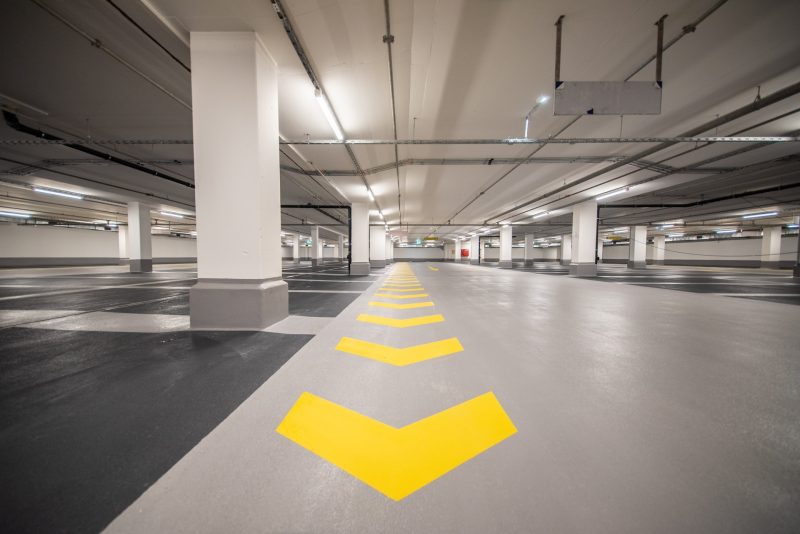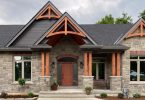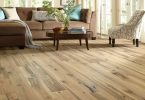Advantages of permeable solutions for parking. Almost every business, whether for customers or employees, has parking spaces. There are solutions to make these parking lots environmentally friendly and reduce the risk of flooding. These are transparent solutions for car parking. Thanks to permeable paving solutions, you can easily meet current commercial standards. In addition, they bring indisputable benefits to any entrepreneur.

Source: Unsplash
Key benefit number 1: Reduced risk of flooding
Most commercial parking lots are paved with impervious materials such as asphalt or concrete. Unfortunately, these materials do not provide effective and safe drainage of rainwater. Additional materials are often required to balance drainage and prevent flooding, which is costly. Permeable grids for paving slabs allow water to flow through the floor below. As a result, it is a much greener approach to stormwater management. By using a permeable grid, as opposed to a drainage system, long-term maintenance costs are also significantly reduced. Waterproof pavers require little maintenance and can last for years.
Key benefit number 2: Quick setup
It takes just one or two days to lay waterproof pavers. Waterproof pavers require only earthworks and foundation installation, which can be completed in one day. The standby time is short, you can use all the features immediately.
Key advantage number 3: Reliable infrastructure
The materials from which the trench drain parking lot is made are extremely reliable and durable. There is a sufficiently large carrying capacity per square meter. This means that waterproof pavers can easily handle different levels of weight, traffic, other loads, etc. without compromise. Waterproof paving also surpasses the durability of concrete and asphalt with its characteristics and capabilities. This paper is designed for commercial use and will last longer than a normal surface. Thus, such paving is independent of load or traffic conditions.
Key advantage number 4: 100% recycled
Permeable paver is recycled, making it the most environmentally friendly paver on the market. The key benefits of using recycled plastic means that less plastic ends up in landfills and oceans, giving plastic a second life and protecting the environment from pollution. It also reduces the carbon footprint used in the manufacturing process of various materials.
Key advantage number 5: Reasonable price
Pervious paving costs significantly less per square foot than concrete paving. The surface contains water permeability and water retention. Installation and maintenance are cheaper. The water-permeable coating makes the use of land much more efficient. This eliminates the need for a dedicated drainage area that can be converted into additional parking space. This in turn has short and long-term benefits.
Key advantage number 6: Style options
The coating is affordable and environmentally friendly, you don’t have to sacrifice style to take advantage of its features and key benefits. The waterproof covering for the track can be chosen following the design of any space, for the interior filling there are many available color options. There are also high-visibility parking signs to help you stand out. It looks just as effective, if not more elegant, than concrete or asphalt alternatives. Parking lots are an easy target for landscaping by installing permeable pavement instead of asphalt or concrete. Permeable gratings provide a very effective drainage solution and reduce the risk of flooding. Such a coating is easy to install and ready for any load in a matter of days. From a financial perspective, a permeable surface also has numerous long-term and short-term cost benefits. This coating takes up less space than its alternatives, requires less maintenance, and can be installed with minimal effort.
How can you increase the waterproofing of the surface effectively and quickly?
A permeable surface is made with the sole purpose of allowing rainwater to flow through it, in order not to damage the environment and not contaminate drinking water sources. In the parking lot, all the dirt and oils flow into the storm sewer, after which the dirty water enters ponds, rivers, and wells, all this pollutes the environment, which has a bad effect on the ecology.
The water-permeable surface is actively used in parking lots located in ecological zones, as well as on private plots, near the house and garages. This is done so that dirt with petroleum products from motor vehicles goes straight into the ground, and does not flow down the road to a water source. When laying the surface, such materials as geotextile and fine gravel are used. A sand cushion is not required when laying a waterproof surface. If the soil in the parking lot where you want to install a waterproof coating is sandy, then a gravel pillow should be made with a certain thickness. This is necessary because, with sandy soil, water will move quickly, seeping into the soil, with clay soil, water will move more slowly, and for this purpose special laying of gravel of different thicknesses is done.
How to properly install a waterproof coating?
Step 1. If there is an old coating where you want to install waterproofing, remove it with a jackhammer. Then remove the pieces of old pavement from this parking area using a skid steer loader.
Step 2. You need to install the waterproofing at the depth at which you need to add gravel.
Step 3. We tamp the soil using special equipment.
Step 4. We lay the geotextile on the compacted surface of the soil so that the gravel pillow does not go into the soil, this provides the waterproof coating with the necessary resistance to various loads.
Step 5. Add fine gravel to the geotextile.
Step 6. We level the gravel and lay a waterproof coating, after which we compact all the irregularities.
Step 7. Check the surface for bumps and pits.
Step 8. We lay a waterproof coating without the use of solutions and mixtures. We wash the coating with water and see how quickly it passes through water-permeable materials.
If there is a functioning drainage system around the house, then the paving must be made waterproof. Geotextile material is first laid before the deepening, and crushed stone or pebbles are poured on top. The material is pressed into the ground, which makes it possible for the coating not to sag under loads.
A waterproof coating is made with one purpose, so that rainwater goes through it, in order not to spoil the environment and not to clog drinking water sources. With the usual coating in the parking lot, all the dirt and oils flow into the storm drain, after which the dirty water enters the environment, thereby clogging it.
If you want the parking area to be clean and dry, so that the foundation of the building that is near the parking lot is not exposed to moisture, does not collapse, and does not rot, so that there are no puddles and mess, then you need a waterproof coating. The organization of surface drainage is one of the main tasks during the construction of a parking lot, where works on effective drainage are used. The waterproof coating has long proven its necessity and effectiveness. Drainage, a product of any civilization, has been improved by the development of technical technologies and has evolved from drainage ditches along roads to modern permeable pavement equipped with various metal gratings and fasteners.
Rainwater, flowing from the gutters onto the paving stones around the house, can damage the foundation, flood the garage, accumulate in puddles in the most inconvenient places, and cause other problems, especially with self-made mechanisms and other improvised means. These are resources that are difficult to manage. In all cases, the surface must be equipped with gutters, grates, rain barriers, sand traps, etc., and the use of an effective drainage system is required. A waterproof coating not only solves such problems as the orderly drainage of rainwater into the sewer. An organized water-permeable coating prevents water from entering the basement of the house from the nearby groundwater. There are two main methods of water collection – linear drainage (for long areas of the territory) and point drainage (for example, for local drains from downspouts). Do not forget! First of all, drainage is prepared! A waterproof coating is installed after the stages of landscaping and asphalting. Drainage is an artificial system of channels designed for the drainage and collection of groundwater. Each of these channels contained in the drainage of the site is called a drain. A well-designed drainage system and permeable pavement can control, drain or irrigate groundwater. For any country house with a parking lot, the drainage system is of great importance.
Drainage prevents the stagnation of water on the plot of land. Excess moisture affects the soil: trees get sick, plants stop growing, and the soil may begin to subside. In general, groundwater should not rise above a meter for normal plant growth. If in practice the situation is different, it is necessary to lower the groundwater level and start draining the territory. In some cases, it is possible to artificially lower the groundwater level by filling the territory with additional layers of earth. When humidity is high, it is important to install a system that protects you from moisture by properly draining all excess water. With a waterproof coating, you will protect the area from high humidity. A high-quality system and the correct laying of gutters require the use of materials that do not retain moisture, such as gravel. It is possible to install a waterproof coating and drainage together. For waterproofing to work properly, waterproofing must be installed around pipes that are made of quality materials.
Overwetting of the soil and water-permeable materials of a reliable coating
Waterlogging of the soil can have several key reasons: the site is located on a slope where water flows (stream, groundwater seepage, spring snowmelt, etc.), and the site is surrounded by houses with deep foundations. What can increased soil moisture lead to? Excessive moisture can damage vegetation and negatively affect the condition of buildings located near this area. Soil moistened in winter freezes and begins to expand strongly in all directions. As a result, layers of earth begin to press on the foundations of buildings. As a result, the basement becomes unusable, there are cracks in the walls, and distortion of door and window openings. To avoid this, it is necessary to use a high-quality waterproof coating. Surplus water from the surface is diverted through interconnected pipes, then diverted off-site.
However, this is a very approximate description of the drainage system, in reality, everything is a little more complicated. Depending on the soil conditions and the location of the object, different drainage systems are installed. Clay soils, for example, have very poor water permeability, which leads to stagnation of water on the surface. A waterproof coating is used to divert water outside the site. The creation of such a system should be approached very carefully. At the same time, you should not abuse small drainage tiles, as this can lead to uneven drainage. The drainage system itself can be implemented in separate areas, it can be installed over the entire area according to the principle of a parallel line. It is possible to determine the method of arrangement of the drainage system depending on the presence of various obstacles on the site. The water-permeable coating ensures uniform drainage of water from the site. What do you need to know when designing a drainage system? The way the cover is placed and the composition of the soil are key factors, if they are not taken into account, then it makes any system a useless set of pipes. Systems with drainage are designed for soils with low water permeability. For example, for clay soils, systems are installed where drainage is arranged every 10 meters, and for sandy soils – every 50 meters.
The effectiveness of the waterproof coating largely depends on the installation depth. Here you need to find the right limit. In this way, groundwater simultaneously nourishes plants and does not flood the site. It is necessary to take into account not only the composition of the soil but also the plants growing in it. The slope at which the water drainage mechanisms are located on the coating depends on the thickness of the gutters. The thinner the gutters, the steeper the slope should be. Pipes are laid in specially dug trenches of the required depth. At the same time, the width of the trenches should be at least three diameters of the drainage pipe. Geotextile is laid on the floor, then crushed stone is poured. The thickness of the crushed stone layer should correspond to the diameter of the drainage. Then everything is covered with sand and covered with soil. In some cases, when it is not possible to drain the water into the reservoir, the systems are equipped with wells and pumps.
Before starting the construction of such a drainage system, it is necessary to determine the level of groundwater. It is almost impossible for an inexperienced person without special equipment. For this, it is necessary to involve specialists who will carry out a topographical survey of the site and detailed drawings. A specialist can determine the level of groundwater at any time of the year. Drainage systems can be opened or closed. An open drain is quite inexpensive and easy to use. To create an open system, it is necessary to dig drainage ditches throughout the territory and make sure that they are not clogged.
Latest posts by Canadian Home Trends (see all)
- Dining Room Design Tips - July 13, 2025
- Practical Luxury in Forest Grove - July 13, 2025
- The Hidden Value of Great Design - July 13, 2025






